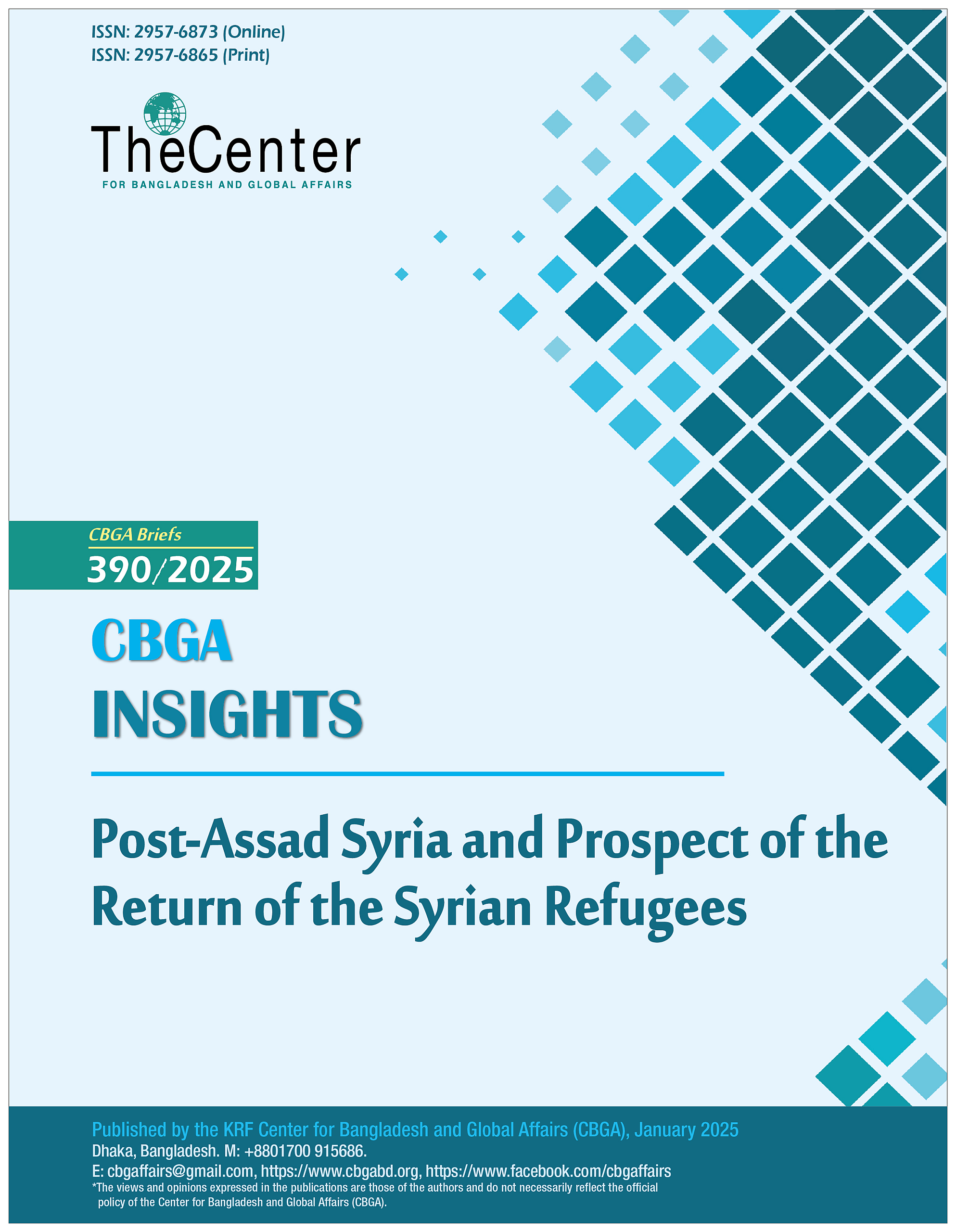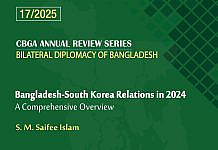
The infamous Assad dynasty came to an end on 8 December 2024, when the rebel group Hayat Tahrir al-Sham (HTS) took control of the capital Damascus following less than two weeks of nonstop fighting throughout the northwest region of Syria. This led to the abrupt flight of former Syrian President Bashar al-Assad to Moscow. The fall of the Assad regime marks a critical juncture for Syria and its people, particularly the over 13 million displaced Syrians. For more than a decade, these refugees have endured harsh living conditions, economic hardship, and diminished international support while seeking stability and safety in host countries. The prospect of returning to their homeland offers hope. However, Syria’s shattered economy destroyed infrastructure, and its unstable political authority makes the path to return embedded with challenges. This brief explores the complexities surrounding the potential return of Syrian refugees and the conditions necessary for their reintegration into post-Assad Syria.
There are currently about 5.2 million Syrian refugees registered in surrounding countries, with almost one million of them residing in Germany. After more than 13 years of displacement, more than 1.3 million Syrian refugees in Jordan are hoping for stability in Syria after the overthrow of the Assad administration. So far, over 8,000 Syrians have tried to return from Jordan, but the majority are still cautious because of Syria’s broken economy and poor infrastructure. Many want to hold off until security stabilizes and their homes are rebuilt.
Supporting refugees in the face of diminishing international help presents difficulties for Jordan. In 2024, only 40% of the money received in 2023 had been given to Jordan’s Syrian refugees, according to an IMF report. Jordan’s ability to deliver necessary services has been challenged by this funding cut, which has increased social and economic pressures. The biggest refugee camp in Jordan, Zaatari, faces dwindling humanitarian aid, a lack of work prospects, and power and water outages. In an attempt to encourage voluntary returns, Jordanian officials have stepped up their efforts, preparing border personnel and working with the Syrian Embassy in Amman. However, because of the uncertainties surrounding Syria’s recovery and administration, they expect low return rates in the near future. Refugees long to rebuild their lives but are cautious about returning prematurely.
At the same time, some nations that are housing a sizable Syrian population view the political change as an opportunity. Some of these nations started to view the ongoing presence of Syrian refugees on their soil as a political liability in the years following the outbreak of the civil conflict in Syria in 2011. Prime Minister Najib Mikati of Lebanon, where a third of the population is Syrian refugees, has urged Syrians to return since Bashar al-Assad’s overthrow, citing a burden on Lebanon’s resources. The chancellor of Austria, which is home to 100,000 Syrians—the second-highest number in Europe after Germany—announced that the country will give Syrians who return a “return bonus” and is developing a scheme to repatriate Syrians with criminal records.
The impending elections in February 2025 have heightened the discourse in Germany. Thus, dramatic and mainly unsupported claims of assisting and possibly compelling returns to Syria were made within hours of Assad’s removal from Damascus, and these claims garnered extensive global publicity. Such actions have a divisive effect, spreading fear and uncertainty among Syrians already residing in Germany and portraying the asylum system as a roadblock to swift political action rather than a legitimate tool offering much-needed protection and legal safeguards.
However, the reality on the ground must temper the hopes of both Syrians and their hosts: Syria is still unstable, much of it has been damaged or destroyed by the conflict, and it cannot sustain a large number of returning residents. For many Syrians, the situation in Syria is too unstable to predict when or if returning would be safe, let alone appealing. Returnees will confront severe housing shortages, infrastructure deficiencies, and restricted employment opportunities, especially in the construction, industrial, and agricultural sectors, in addition to the ambiguity surrounding who will rule various regions of Syrian land. Following al-Assad’s overthrow, Syrians have been returning to Syria in greater numbers than ever before, but many of these visits are probably short-term celebrations and, more crucially, to check on the situation. In the near future, conditions on the ground are unlikely to be stable enough for people to think about returning home permanently. Moving back to Syria can not be an option or a desirable result, depending on each Syrian’s unique circumstances and their own judgment of the advantages of doing so.
Additionally, host nations may find it more challenging to persuade Syrians to flee than they would want. Many Syrians have been in Europe long enough to be granted naturalization or long-term residency, which allows them to stay there indefinitely without having to keep up their refugee status. Nearly 180,000 Syrians were permanent residents of EU nations as of December 2023, and since 2013, over 300,000 have obtained EU citizenship. The more than 780,000 Syrians in the EU who still have subsidiary protection or refugee status are less safe. According to EU legislation, states may be able to refuse to renew or even revoke the status of refugees whose claims were motivated by fear of persecution by the Assad administration.
Additionally, from a strategic perspective, a strategy of forced return is rarely logical. The Home Ministry and other government agencies that are essential to migration, such as border controls, have just started to be maintained, staffed, and strengthened by the new transitional government. The current population of Syria is too much for the economy to handle, let alone a rush of millions of people who would return with no prospects or a place to call home. Only 28% of the money needed for humanitarian operations has been obtained by the UN, and it is barely able to sustain a surge.
Around 90% of Syrians who survived the war are now living in poverty as a result of the country’s economy having virtually collapsed. International assistance to aid in Syria’s reconstruction has not yet been decided, as the United States and European Union continue to impose economic sanctions on the country. People returning to Syria are not guaranteed employment or means of subsistence until the economic reconstruction process starts. Additionally, they are not guaranteed access to professional training or educational possibilities. Another catastrophe might arise if millions of individuals return to a nation that lacks the physical or financial capacity to support them. Since the start of the conflict, Syria’s GDP has drastically shrunk, and businesses that formerly supported millions of people have failed. A vital component of the pre-war economy, agriculture has been severely damaged by both fighting and climate change. A lack of job prospects has resulted from the destruction or abandonment of numerous manufacturing businesses. A large portion of the population can no longer buy basic products due to inflation and currency devaluation.
The international community and host countries play a critical role in supporting Syrian refugees’ eventual return to a safe and viable Syria. Drawing from historical parallels like Bosnia and Côte d’Ivoire, where repatriation took decades, it is clear that Syria’s recovery will require significant time. The UNHCR maintains that Syria is not yet safe for returns, emphasizing the need to address security, humanitarian, and societal challenges before repatriation. Host governments must provide stability in refugees’ legal status, avoiding ambiguous policies that may incite panic or unintended consequences. Sustainable returns require careful planning, including temporary trips for returnees to assess conditions and secure housing or employment. Reintegration support, such as direct cash grants and community initiatives, is essential, along with robust, long-term assistance for the Syrian government to reconnect returnees with public services. Donor countries must also increase development support for Syria and its neighbors to manage moving populations and infrastructure needs. While an inclusive and stable Syrian government is ideal, host countries must prepare to ensure voluntary, safe returns and continued protection for refugees who cannot return.
The potential return of Syrian refugees to their homeland is a deeply emotional and complex issue tied to their hopes for safety, stability, and economic opportunity. While the fall of the Assad regime has reignited aspirations to return, significant barriers such as insecurity, lack of basic services, and uncertainty in governance hinder immediate repatriation. The future of Syria and its refugees depends on creating conditions that enable them to rebuild their lives with dignity and hope.
– Tahia Afra Jannati is a Research Intern at the KRF Center for Bangladesh and Global Affairs (CBGA).







